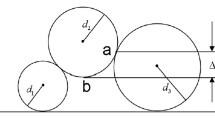Sedimentation of cuttings limits application of gas drilling through a horizontal well section. We have constructed a theoretical model of two-layer flow as applied to flow of the gas and solid particles; we have developed a diffusion theory for gas drilling conditions for horizontal well sections. The calculations are performed using data from real wells. The calculations show that when drilling a horizontal section, a cutting bed will inevitably be formed and we need to control sedimentation of the cuttings by regulating the gas flow velocity. For low gas velocities, the resistance of the particles to motion is mainly created as a result of their collisions with the well wall in the cutting bed zone. For high gas flow velocities, the major resistance is created as a result of collisions of the particles with the well wall in the two-layer flow zone. Based on previous studies of two-layer flow and the cutting bed, it was established that gas injection should be done at the bottom of the well when gas drilling a horizontal section. The ascending gas flow velocity should be 1.5 times higher than the particle sedimentation rate. Only under such conditions is control of cutting bed formation possible.




Similar content being viewed by others
References
R. A. Bagnold, The Physics of Blown Sand and Desert Dunes, William Morrow, New York (1941).
Jiangang Zhou, Yishen Shen, and Enxiang Ma, High Concentrations of Powder Pneumatic Conveying Control and Distribution Technologies, China Metallurgical Industry Press (1996).
G. E. Klinzing, C. A. Myler, A. Zaltash, and S. Dhodapkar, “A simplified correlation for solids friction factor in horizontal conveying systems based on Yang’s unified theory,” Powder Technology, 58, 187–193 (1989).
J. Hong, “A model for gas-solid stratified flow in horizontal dense-phase pneumatic conveying,” Powder Technology, 77, 107–114 (1993).
Z. B. Aziz and G. E. Klinzing, “Dense phase plug flow transfer: The l-inch horizontal flow,” Powder Technology, 62, 41–49 (1990).
Xiaohua Zhu, Shaohu Liu, and Hua Tong, “Research on transport of cuttings in gas drilling horizontal well and cuttings falling-prevent joint development,” in: SPE Asia Pacific Oil and Gas Conference. Jakarta, Indonesia 2011; SPE 145612.
Wen-Qing Yang, “Correlations for solids friction factors in vertical and horizontal pneumatic conveying,” AIChE Journal, 20, No. 3, 605–607 (1974).
P. Doron and D. Granica, “Slurry flow in horizontal pipes—experimental and modeling,” Int. J. Multiphase Flow, 13, No. 4, 535–547 (1987).
P. Doron and D. Barna, “A three-layer model for solid–liquid flow in horizontal pipes,” Int. J. Multiphase Flow, 19, No. 6, 1029–1043 (1993).
Chin-yung Wen and H. P. Simous, “Flow characteristics in horizontal fluidized solids transport,” AICHE Journal, 5, No. 2, 167–172 (1959).
F. Engelund and J. Fredsøe, “A sediment transport model for straight alluvial channels,” Nordic Hydology, 7, No. 5, 293–306 (1976).
S. J. White, “Plain bed thresholds for fine grained sediments,” Nature, 228, No. 5267, 152–153 (1970).
Y. M. Chiew and G. Parker, “Incipient sediment transport on non-horizontal slopes,” Journal of Hydraulic Research, 32, No. 5, 649–660 (1994).
A. S. Paintal, “A stochastic model of bed load transport,” Journal of Hydraulic Research, 9, No. 4, 527–554 (1971).
F. J. Cabrejos and G. E. Klingzing, “Incipient motion of solid particles in horizontal pneumatic conveying,” Powder Technology, 72, 51–61 (1992).
Author information
Authors and Affiliations
Corresponding author
Additional information
Translated from Khimiya i Tekhnologiya Topliv i Masel, No. 6, pp. 42 – 45, November – December, 2014.
Rights and permissions
About this article
Cite this article
Xiaoguang, Y., Gonghui, L. & Jun, L. Application of a Special Technique for Controlling the Cutting Bed Height in Gas Drilling of Horizontal Wells. Chem Technol Fuels Oils 50, 508–515 (2015). https://doi.org/10.1007/s10553-015-0557-1
Published:
Issue Date:
DOI: https://doi.org/10.1007/s10553-015-0557-1




